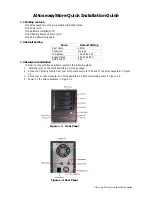
16
158004.B00
2.3 SDRAM
The main memory of the TP400 consists of Synchronous Dynamic RAM (SDRAM)
chips. The chips are mounted on a small 144-pin printed circuit board called a
SODIMM module (small outline dual-in-line memory module). The memory is 64-bits
wide. Four options are available:
•
32M bytes
•
64M bytes
•
128M bytes
•
256M bytes
The standard configuration of the TP400 is to have no SDRAM fitted. SODIMM
modules must be ordered separately and fitted into the SODIMM socket on the
TP400. Thus users can select the correct memory capacity for their application. See
Appendix D: TP400 Options and Ordering Information.
The use of SODIMM modules for SDRAM memory means that the SDRAM
configuration can be altered at a later stage. DSP Design carry stock of the SODIMM
modules described above, or customers may provide their own. PC100 SODIMM
modules should be used.
Care must be taken when handling the TP400 and associated components. Ensure
that all anti-static handling precautions are taken. See Appendix B: TP400 Setup
Procedure for instructions on installing SODIMM modules.
The BIOS automatically determines the amount of SDRAM present and configures
the internal Geode GX1 registers accordingly. Registers within the Geode GX1 chip
allow SDRAM timing to be optimised according to CPU speed and SDRAM access
time. At reset the SDRAM timing defaults to the slowest case and the BIOS then
optimizes timing for the best performance.
Some of the SDRAM is taken from the processor and allocated to the graphics
controller, using a technique referred to as UMA (unified memory architecture). Up to
4.5M bytes may be allocated to graphics; the BIOS configures the correct amount
depending on the graphics mode selected in the BIOS Setup menu.
Note that only the first 640k bytes of SDRAM are usually directly accessible by DOS.
Some of the remaining SDRAM is used to shadow the BIOS (see section 6.1) and
the remainder is re-mapped above the 1M byte boundary, where it can be used by
DOS extenders and by Windows and other operating systems.
Memory between C0000H and FFFFFH (the top of the 1M-byte block) can be used to
shadow BIOS code. This allows the BIOSes to run at the fast SDRAM speed rather
than the slow EPROM speed. Typically the system BIOS (from E8000H - FFFFFH),
the VGA BIOS (from C0000H - C7FFFH) and the Flash File System (from CC000H -
CFFFFH) driver are shadowed. Memory beyond the 1M byte limit is available for
Windows and other protected mode operating systems.
Summary of Contents for 104-plus
Page 2: ... This page is intentionally left blank ...
Page 4: ... This page is intentionally left blank ...
Page 76: ...66 158004 B00 This page is intentionally left blank ...
Page 86: ...B8 158004 B00 This page is intentionally left blank ...
Page 88: ...C2 158004 B00 FIGURE C1 MAIN BOARD TOP COMPONENT PLACEMENT ...
Page 89: ...158004 B00 C3 FIGURE C2 MAIN BOARD BOTTOM COMPONENT PLACEMENT ...
Page 90: ...C4 158004 B00 FIGURE C3 DAUGHTER BOARD TOP COMPONENT PLACEMENT ...
Page 91: ...158004 B00 C5 FIGURE C4 DAUGHTER BOARD BOTTOM COMPONENT PLACEMENT ...
Page 92: ...C6 158004 B00 FIGURE C5 MAIN BOARD MECHANICAL DIMENSIONS ...
Page 93: ...158004 B00 C7 FIGURE C6 DAUGHTER BOARD MECHANICAL DIMENSIONS ...
Page 94: ...C8 158004 B00 This page is intentionally left blank ...
Page 100: ...D6 158004 B00 This page is intentionally left blank ...
Page 116: ...E16 158004 B00 This page is intentionally left blank ...
Page 134: ...H6 164004 C03 This page is Intentionally left blank ...
Page 136: ...J2 164004 C03 FIGURE J1 TP400ET MECHANICAL DRAWINGS FIGURE J2 TP400ET CIRCUIT DIAGRAM ...
Page 138: ...K2 158004 B00 FIGURE K1 TP300USB MECHANICAL DRAWINGS FIGURE K2 TP300USB CIRCUIT DIAGRAM ...
















































